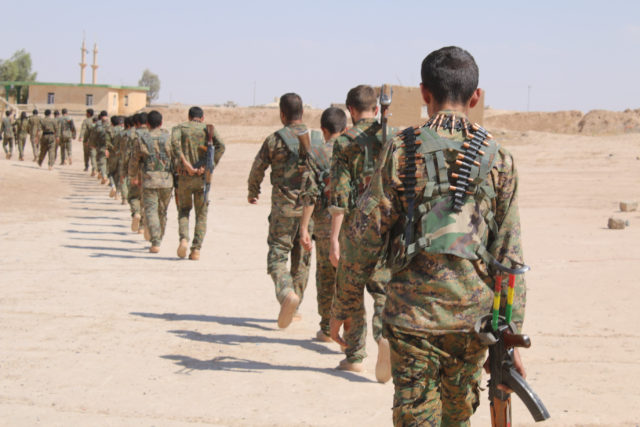
Yezidis and Yerevan Complicating Moscow’s Efforts to Influence Kurds in Iraq and Syria
Publication: Eurasia Daily Monitor Volume: 14 Issue: 54
By:

The convocation, last February, of a Kurdish conference in Moscow that included the Yezidis (Aranews.net, February 16), combined with new Kurdish-Yezidi claims that the Russian military has promised to provide them with training (Deutsche Welle, March 21), have highlighted Moscow’s continuing effort to win over those minority nationalities to its side in Iraq and Syria.
More than that, these developments have drawn attention to the Yezidis themselves, an often neglected but sometimes critically important player in the Middle East and the South Caucasus. But Armenia, which has a sizeable Yezidi population that has grown over the last five years as a result of the influx of recent refugees, has been undercutting the Russian government’s ability to gain influence over the Kurds. All this is despite the long history of Russian involvement with the Kurds going back to imperial times and, most prominently, in the aftermath of World War II (on this, see James Aldridge’s roman à clef, The Diplomat, London, 1949).
The Yezidis are estimated to number 700,000–2,000,000, and they live throughout the Middle East and the South Caucasus. At least half a million of them are found in Iraq, and a large community resides in Syria. In the former Soviet space, there are approximately 40,000 in Russia, 35,000 in Armenia and 14,000 in Georgia. These provide the cadres from which Moscow has been deploying its agents of influence into the Middle East. Most but not all of the Yezidis identify and are identified by others as Kurds, but they are set apart from that larger nation by their religion, which is based on a combination of Zoroastrianism, Christianity and Islam. As such, the Yezidi religion is sometimes characterized by others as “devil worship” or even worse (Kavpolit.com, April 21).
Armenia has always had a significant Yezidi Kurdish minority—it is the second largest ethno-religious group there—even though the country is the most mono-ethnic and mono-religious among all the former Soviet republics. Because of that, Moscow has traditionally used Armenia and Armenian Yezidis and Kurds to promote its interests among the Kurds of Iraq and Syria. And Yerevan has not been shy about declaring its willingness to work hand in glove with Moscow in this regard (Kavpolit.com, April 21).
Nonetheless, the massive recent influx of Yezidis to Armenia from Iraq and Syria has sparked an almost equally large outflow of Yezidis from this South Caucasus country. According to one estimate, some 70 percent of Yezidi refugees have since left, either to return to their original homelands or to travel on to the West (Kavpolit.com, April 21). Their reasons are two-fold according to Rizvan Guseynov, a Baku-based specialist on the Middle East. On the one hand, many of them have left because they cannot find any work in Armenia’s still-depressed economy. And on the other, they have faced a disorienting combination of official declarations of friendship from the government but open hostility from the Armenian Orthodox Church and, apparently, many ordinary Armenians as well.
At Moscow’s behest and in Armenia’s own national interests, Yerevan has been pursuing the Yezidis actively over the last few years, hoping to exploit this community because, like the Kurds, the Yezidis tend to be anti-Turkish. Yerevan and Moscow’s goal is to turn the Yezidis into an actively pro-Armenian and pro-Russian instrument to counter Washington’s efforts to form tactical or strategic alliances with the Kurds in the region. As Guseynov notes, there have been a series of visits by Armenians to Yezidi areas in Iraq and Syria as well as by Yezidi officials from there to Armenia. Reportedly, there has also been talk of opening consulates. And Armenian investment has already been seen in the Syrian and Iraqi Yezidi areas, most of it by Yezidis currently living in Armenia. All these moves, plus Yerevan’s willingness to give Yezidis refugee status, has won Yerevan and Moscow support from this group.
But almost all of that good will may potentially be lost because of the decision, two years ago, of the Armenian Orthodox Church to ban marriages between Armenians and Yezidis. In the words of the Church leadership, the Kurdish Yezidis “worship Satan.” Any Armenian who married one, the Church said, would be excluded from the Armenian communion (Blagovest-info.ru, November 18, 2015). Not surprisingly, many Yezidis were offended, something made worse because many Armenians felt that this was a signal to isolate rather than make friends with the members of that community. In one dramatic move, all the Yezidis from the Iraqi city of Shangal decided to return home (Kavpolit.com, April 21).
Some Yezidis in Armenia have remained loyal to Yerevan and Moscow largely because of the anti-Turkish position of the first and monetary support from the latter. But they are far outnumbered by Yezidis who now view Armenians and Russians with obvious distaste and even outright hostility, thus costing Russia the support of an ally it had relied upon for more than a century (Nezavisimaya Gazeta, July 14, 2016).
All this may seem like a small development in the grand scheme of things, but in fact it highlights three important issues: First, Russia cannot count even on Armenia to conduct its affairs in ways that will invariably support Moscow’s goals. Second, Russia has now put in play a group whose allegiances were really not in question until quite recently. And third, this Yezidi shift underscores that alliances in Syria and Iraq that many assume are eternal are actually far more fragile and situational.



